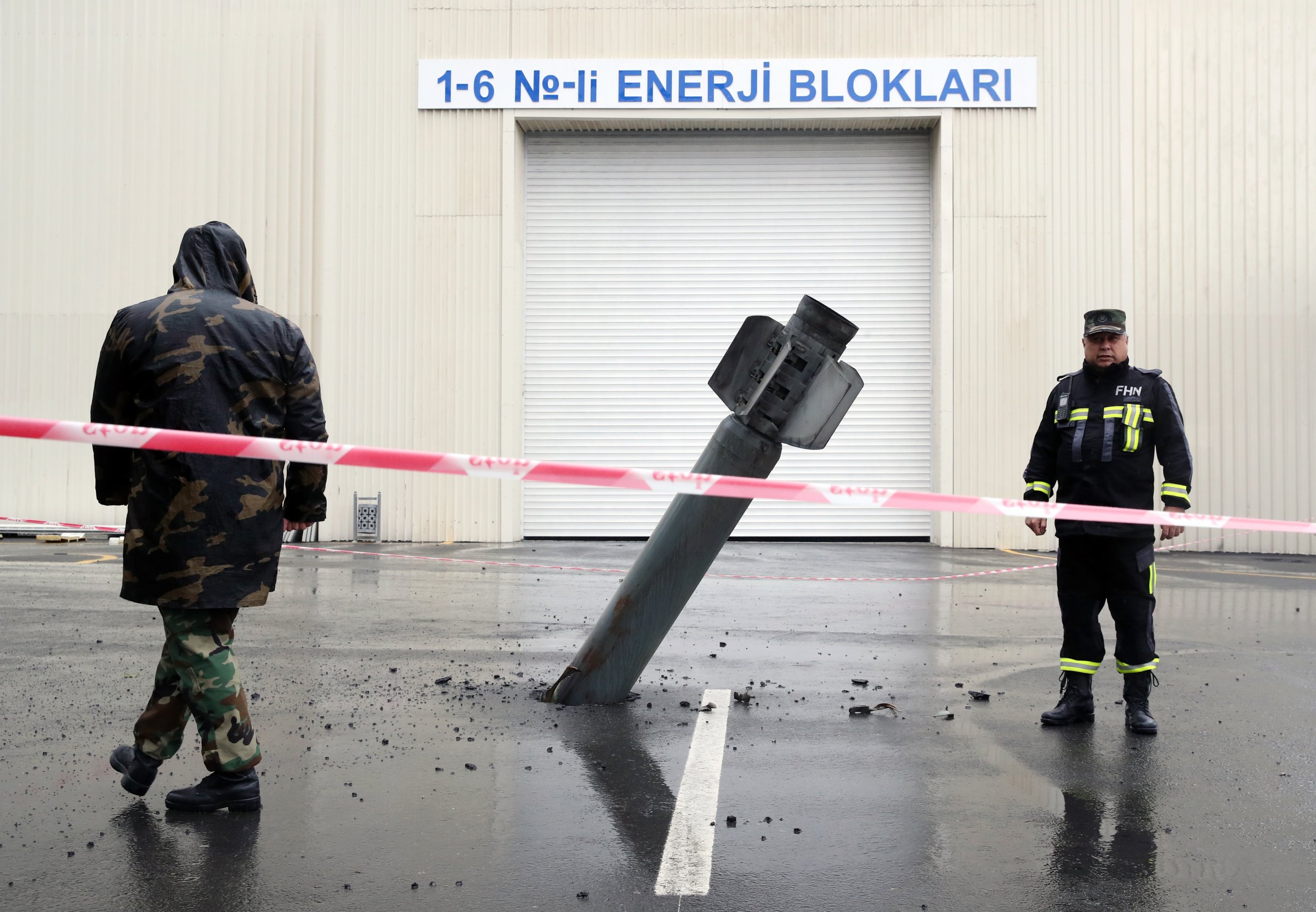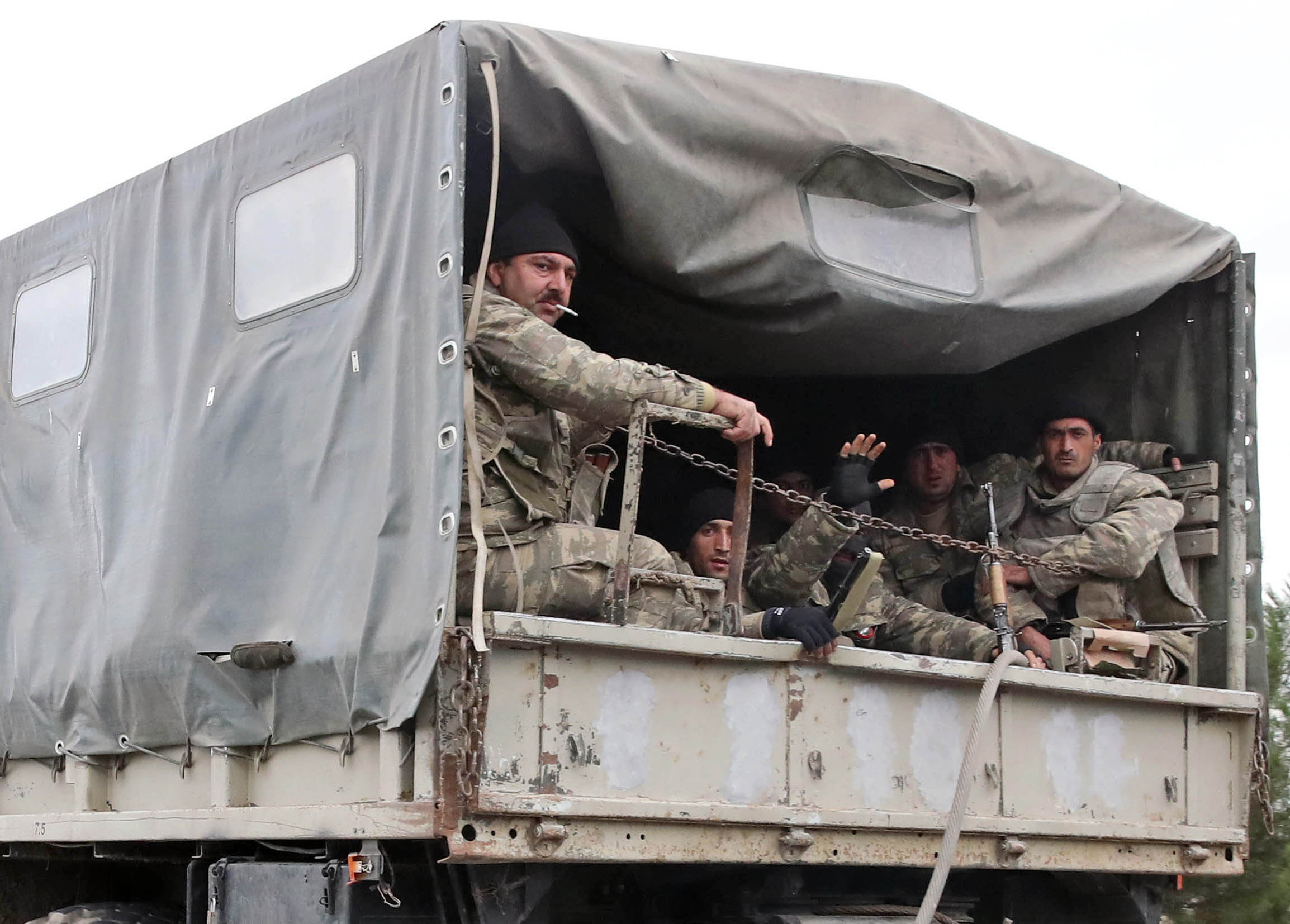
When Armenia and Azerbaijan resumed Europe’s oldest “frozen war” over the breakaway territory of Nagorno Karabakh on Sept 27, the intimate nature of the fighting—between trenches so close that soldiers on opposing sides could shout to each other in some places—gave the false impression of a bitter but parochial skirmish.
In fact, the battle already threatens to bleed beyond the mountainous 1700-square mile enclave in the South Caucasus to engulf Azerbaijan and Armenia in all-out war, and risks provoking an even wider conflagration. In an interview with TIME, Armenia’s Prime Minister Nikol Pashinyan doubled down on accusations that its bitter rival Turkey is already intervening militarily on behalf of Azerbaijan, claiming President Recep Tayyip Erdogan is vying to extend his influence in the region.
“Armenia and Karabakh have now become a civilizational front line,” Pashinyan told TIME by phone on Oct. 2, accusing Erdogan of sending between 1,500–2,000 Syrian “terrorists” to the region in support of Azerbaijan, a country with whom Turkey shares deep cultural and economic ties. In concert with Turkey’s military incursions into Syria and Libya and its volatile maritime standoff in the East Mediterranean, Pashinyan claimed: “Turkey’s action is nothing short of action aimed at reinstating the Ottoman empire.”
Turkey’s and Azerbaijan’s foreign ministries have both denied that Turkey is intervening directly or using mercenaries, although President Erdogan has pledged to support “brotherly Azerbaijan” with “all our means.” But Turkey, which has called for Armenia to “leave the land it occupied” is far from the only country with skin in the game. Iran, which is allied with Armenia but houses a large ethnic-Azerbaijani population, warned both Armenia and Azerbaijan against “intrusion” into its territory amid reports of rockets and even helicopters falling below its northern border. The conflict potentially puts Turkey at odds with both Russia, which has deep ties with both countries, and France, which has accused Erdogan of sending “jihadists” into battle. Georgia, meanwhile, has expressed alarm over the escalation and offered its capital Tbilisi as a neutral venue for talks.
Read more: The Armenia-Azerbaijan Fighting Could Spiral Into A Larger Regional Conflict
The conflict is best understood in the context of pipeline politics involving major powers jockeying for geopolitical influence in the oil-rich Middle East and neighboring Caucasus, says Charlotte Dennett, an expert in resource-based politics. American and British oil companies have since the mid-1990s poured billions of dollars into Azerbaijan, whose three major transnational oil pipelines run only a few miles from the Nagorno Karabakh line of contact.
“Small wonder that regional leaders and their intelligence agencies are watching the whole region with heightened concern,” Dennett tells TIME. “A single spark could set off a conflagration that could engulf the entire world.”

While tensions between Azerbaijan and Armenia go back hundreds of years, the conflict over Nagorno-Karabakh is a more recent concern. It dates back to the fall of the Soviet Union when a brutal six-year war killed about 30,000 people before it ended in a 1994 ceasefire that left Armenia in de-facto control of the territory, even though the international community considers it Azerbaijani land.
Various peace processes led by the so-called Minsk Group coalition of Russia, France, and the U.S. have failed to resolve the decades-long dispute. After a threeway Oct.1 call between French President Emmanuel Macron, Russian President Vladimir Putin, and U.S. President Donald Trump, the tripartite coalition called for an immediate ceasefire, but its persistent failure to advance a peace process has damaged its credibility, particularly with Azerbaijan. Only two days before fighting broke out, Azerbaijan’s President Ilham Aliyev complained to the UN General Assembly of the Minsk Group’s lack of progress and repeatedly stated his desire to restore Azerbaijan’s control of Nagorno Karabakh and its adjacent territories.
“For us indeed, it’s a patriotic war,” Foreign Ministry spokeswoman Leyla Abdullayeva told TIME on Oct. 3. The Minsk Group’s neutrality doesn’t acknowledge the ongoing violations of the rights of the hundreds of thousands of Azerbaijanis expelled from the area, she said, or that Armenia is the occupying force. “We need to eliminate the fact of occupation, otherwise we will not see lasting peace and security in the region.”
Pashinyan, who came to power in 2018 after leading Armenia’s peaceful Velvet Revolution, had briefly raised hopes of a peaceful solution to the bitter conflict. But Azerbaijan was angered by Pashinyan’s son undertaking military service in Nagorno Karabakh, as well as Armenia hosting its 2019 pan-Armenian games in its main city, Stepanakert. In August 2019, Pashinyan declared in a speech that Nagorno Karabakh “belongs to Armenia, period.”
Read more: Armenia’s Peaceful Protester Takes Power in a Bloodless Revolution
Asked whether his actions in the run-up to the conflict were provocative, Pahsinyan told TIME that when he came to power he made a historic call for a solution that met the needs of Azerbaijanis as well as Armenians. His subsequent statements came only in response to Aliyev’s reiteration of Azerbaijan’s maximalist position, he said.
In a televised address to the nation on Oct 4, Aliyev reiterated his condition for a ceasefire: that all Armenian forces “abandon our territory,” a condition Armenia would certainly reject. “This is the end. We showed them who we are. We are chasing them like dogs.”
Pashinyan said Armenia’s conditions for a ceasefire are Turkey “discontinuing [its] engagement” and “the withdrawal of mercenaries and terrorists or their elimination.” He claimed, without presenting evidence, that mercenaries were harassing Azerbaijani villages, demanding the implementation of shariah law, and ransacking shops selling alcohol. In his interview with TIME on Oct 2, Pashinyan estimated 1,500–2,000 “terrorists” were present; earlier, Armenia’s ambassador to Russia had suggested there were 4000.
Despite these apparent inconsistencies, there is a growing consensus that at least some Syrians fighters are involved in the conflict. Both France and Russia have accused Turkey of deploying mercenaries in the South Caucasus, as it has in Libya. The Guardian has spoken with Syrian fighters in Azerbaijan who say they were recruited by a Turkish contractor in July. And cellphone footage that circulated on social media appears to show Arabic-speaking fighters celebrating the capture of an Armenian military barracks on Oct.3. That same location features in a video Azerbaijan’s Ministry of Defense posted on the same date. Monitors have also geolocated photos of what appear to be Syrian fighters to Azerbaijan.
Olesya Vartanyan, International Crisis Group’s (ICG) senior analyst for the Southern Caucasus says “there is no evidence” to support Azerbaijan’s counterclaims that Armenia is using foreign mercenaries from the Middle East.
On the Nagorno Karabakh frontline, the fighting continues to worsen. More than 220 soldiers and at least 19 civilians had been killed in Armenian-controlled territory and Armenia proper by Oct 5. Internet blackouts enforced by Baku, as well as electricity cuts, make accurate information difficult to obtain, but Azerbaijan’s foreign ministry told TIME on Oct 3. that 19 Azerbaijani civilians had been killed and 300 houses destroyed, along with schools, kindergartens, and other civilian infrastructure.
Read more: Why Erdogan’s Love Affair with the Ottoman Empire Should Worry The World
In the mountainous northeast, the site of some of the heaviest fighting, some military outposts have changed hands twice or more since Sept 28, suggesting a protracted and bloody conflict. Footage monitors deem credible appears to show cluster bombs being used in civilian-populated streets of Stepanakert—which had previously turned out its lights to avoid airstrikes and went dark on Oct 5. Meanwhile, at least one civilian was reportedly killed and four more wounded in a rocket strike in Ganja, Azerbaijan’s second-largest city some 60 miles north. Azerbaijan accuses Armenia of deliberately targeting civilian infrastructure. Turkey has accused it of “targeting civilians.”
De-escalation might yet happen. Russia, which has a military base in Armenia but also maintains close ties to Baku elites, is the likeliest mediator. The problem, says ICG’s Vartanyan, is that “neither Russia, not the French nor the Americans have any kind of realistic peace plan that could provide an alternative to Baku so that it returns to talks in order to achieve its goals of the immediate return of its control over the conflict zone.”
“The longer the fighting goes on, the more advanced weapons that are used, the more civilian and military casualties mount, and the further the fighting extends beyond the disputed territory,” she says, “the more likely outside military intervention becomes.”
More Must-Reads from TIME
- Cybersecurity Experts Are Sounding the Alarm on DOGE
- Meet the 2025 Women of the Year
- The Harsh Truth About Disability Inclusion
- Why Do More Young Adults Have Cancer?
- Colman Domingo Leads With Radical Love
- How to Get Better at Doing Things Alone
- Michelle Zauner Stares Down the Darkness
Write to Joseph Hincks at joseph.hincks@time.com